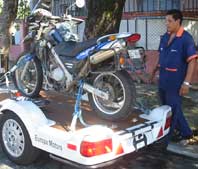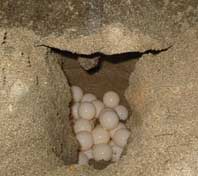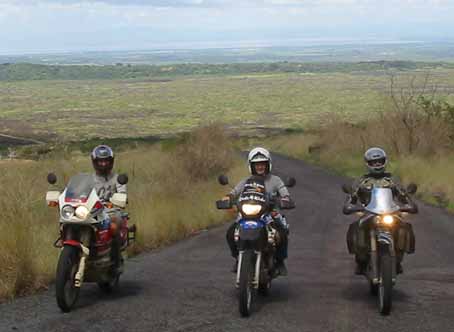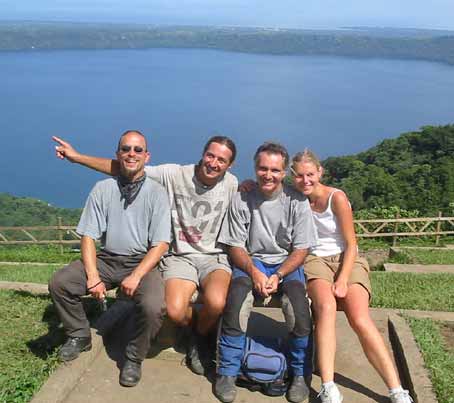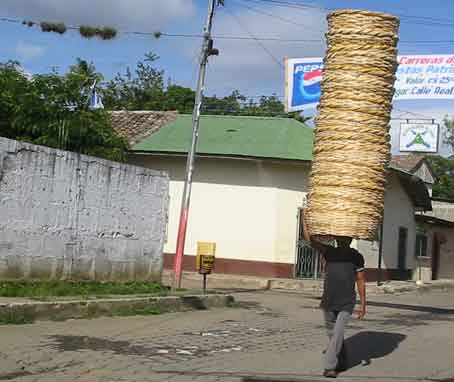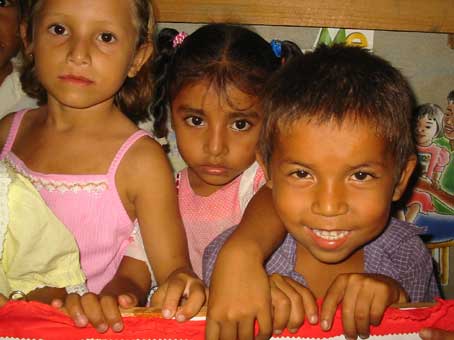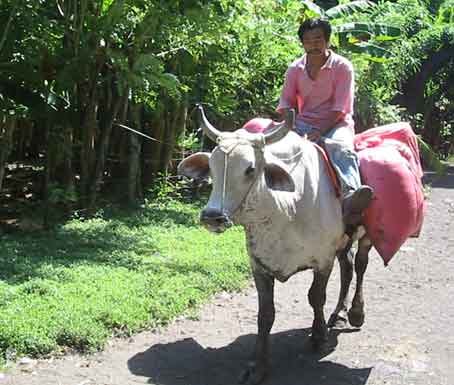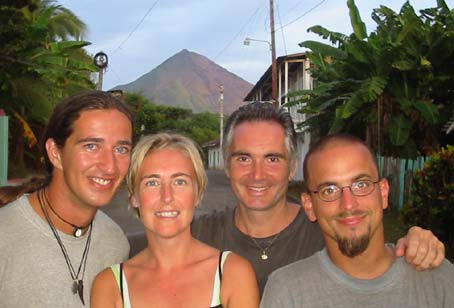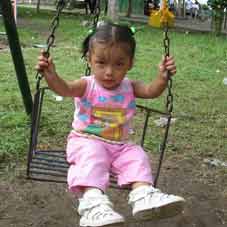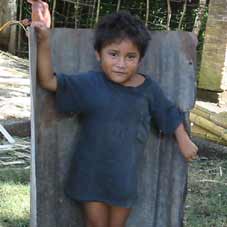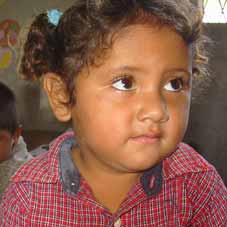The adventures
of the three Musketeers!
Monday,
3 November 2003.
I had found out that there was a BMW dealership (Europa Motors) right
here in San Salvador and after a quick phone call they came with a trailer and
picked up my bike. I went with them to the dealer and met Rafael Segura,
the chief mechanic. The work shop was very high-tech like the ones in Europe
or Australia. Rafael connected my bike to the computer in order to find out
where was the problem and soon he discovered that the problem was the battery.
Everything
else was in order. Unfortunately he did not have
a battery in stock so he just removed one off their brand new bikes and fitted
it on mine. Then I met Hernán Orellana, the manager, he asked
me if I would agree to a press conference the next day and in return he would
take care of all the expense. How could I refuse?
Hernán
came the next day at 4pm to pick me up at my hotel and when we arrived at the
dealership I was surprised to see that all the media was already there including
the television. I did a short presentation of my trip on Power Point and answered
all their questions afterward. Some food was served and everyone seemed happy.
I would like to say thank you to Europa Motors for all their help, particularly
to Hermán Orellana, Rafael Segura and Ricardo Avilés
(pictured).
I left early the next day toward the Honduras border
which
was only 200km away. I have really enjoyed my visit in El Salvador; the people
were always friendly and helpful. Many told me about their experiences during
the war and their opinions about the country's state of affairs. The children
were always polite, curious and quick with the smile.
I arrived at the Honduras border at 11am and left it at 2pm. Again I
had to go through all the paper work for the bike and end up paying more than
US$40 just for the bike. Because I had already visited Honduras and also because
I was running a little late on schedule, I decided to go quickly through Honduras
and straight in Nicaragua. I could have been at the Nicaraguan border later
that evening and through to Honduras that day but I really could not face another
border crossing. I hate them so much that I dread them now and I don't think
that I could have survived two of them in one day. I stopped in the small town
of Choluteca for the night, found a cheap but clean place to sleep and
prepared myself for the upcoming border.
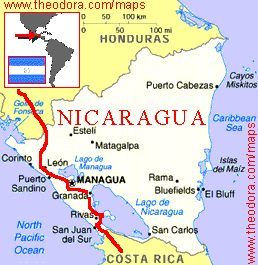
I
arrived at the Nicaraguan border at 8am the next morning and spent the
following two hours filling forms, getting hundred of photo copies, and paying
US$30 for god knows what. I also got ripped off a few dollars while changing
money.
Nicaragua is the largest country in Central America. It is bordered by Honduras
on the north, Costa Rica on the south, the Caribbean Sea on the east and the
Pacific Ocean on the west.
Political events of past decades have had a huge impact on many outsiders perceptions
of this country and many tourists stay away from it. I was here around ten years
ago and I remember
being
thrilled by the many volcanoes, navigable rivers, colonial cities, Caribbean
Islands and deserted beaches.
Economically, Nicaragua remains one of the poorest countries in the hemisphere,
with at least 50% of the population estimated to be living below the poverty
line. Of course Hurricane Mitch did not help things in the fall of 1998.
Nicaragua has a population of around 5,2 million people. Mestizos, of mixed
Spanish and indigenous ancestry, form the majority.
The first 60 km were off road, until Chimandega. It was not really bad except
for the dust made by trucks and buses flying through at high speed. From there
to Granada, my objective for the day, the road was in excellent condition. I
went through Managua (the capital) early in the afternoon and arrived in Granada
(45km further) at around 4pm.
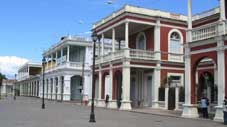
Granada
is Nicaragua's oldest Spanish city and, like Antigua in Guatemala, has preserved
its colonial architectural heritage. It was founded in 1524 and stands at the
foot of Volcan Mombacho on the north-western shore of Lake Nicaragua. Granada
streets are lined with Spanish-style houses with stuccoed adobe walls and large
wooden doors opening onto
cool
interior patios. It has a population of 85 thousand people and I have read somewhere
that the Granadinos have a reputation for being cliquish and stuck up, for example
they drive around in oppressive heat with their car windows up, just so onlookers
will think they can afford air-conditioning. Nevertheless, it is a quiet and
wonderful town and I decided to make it my base for a week. I found a cheap
place to stay where I could park my bike, for US$5.
The next day I rode back to Managua to visit the World Vision office.
I was met by Maria José Jimenez and we organized to visit the Nindiri
project the following Wednesday. It was no easy to find my way in the capital
as only a few streets have signs and hardly any roads have names. Large building,
roundabouts and traffic lights serve as de facto points of reference, and locations
are described in terms of their direction and distance, usually blocks, from
these points. To make things more confusing, sometimes locations are given in
relation to landmarks that no longer exist. The best way for me was to ask direction
all the time and thanks god my Spanish is getting better all the time. Managua
has suffered a lot over the years as natural disasters have thrashed the city
many times. The colonial centre was destroyed by earthquake in March 1931, and
then swept by fire five years later. It was completely rebuilt, only to be knocked
down again by another earthquake in December 1972. This one virtually levelled
Managua, killing 6000 Nicaraguans and leaving over 300,000 others without food
and shelter.
Saturday, 8 November.
Albert Hörmann (my Austrian's friend riding a 750 Honda Africa Twin)
was in town as well so we organized to visit the Masaya volcano. Steffen
Utzmann (Also known as the bearded monkey), a German guy riding a
640 KTM from Alaska to Argentina, decided to join us (the three musketeers).
Albert brought his part time sweetheart Femke (from Holland) with him
and we set out at around 8.30am for the 20km ride. The national park Masaya
is one of Nicaragua most interesting features and it encompasses a pair of volcanoes,
Masaya and Nindiri, which together comprise five craters. Of these, the crater
of Santiago is still quite active and that day it was smoking and steaming.
Legends tell that the pre-Hispanic inhabitants of the area would throw young
women into the boiling lava at the bottom of the crater to appease Chaciutique,
the goddess of fire, and skeletons of these human sacrifices have been
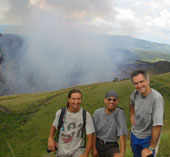
found
in nearby lava tunnels. We were able to ride right up to the crater and, from
there; we had a wonderful view of the surrounding countryside, including the
Lake Masaya. After a walk along the crater we got back on our bikes with the
intention of riding to the nearby village of Catarina. Everything was going
fine until a couple of us decided to over take a car in a no overtaking section
of the road. At this point I will not name the guilty riders; I will only say
that I was not one of them. Of course the others will not agree with me but
since I am writing
the
story I can say whatever I want. Keep an eye in the guestbook as I am sure their
will be some comments from the guilty partie. Anyway, to cut the story short,
one cop saw us and blew his whistle like crazy as we went by without stopping.
We kept going for a few Km until I noticed a taxi behind us blowing his horn
with a policeman hanging out of the passenger's window gesticulating and blowing
a whistle. They over took us and stopped us. The cop flew out of the car and
ran to us. He did not look happy at all and I had the feeling that he was not
going to give us a certificate of good conduct. He asked for our driver's license
and say he would return them to us when we would pay the fine. At first, the
fine was 400 Cordobas (US$28) but he brought it down to 300. We pretended that
we did not understand what he was talking about and that we had no idea what
we had done wrong. That did not help and to make things worse we were told that
the fine had to be paid in the bank and that the bank was
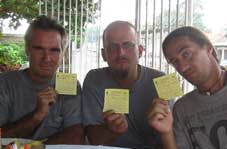
closed
until Monday. He left us with a little yellow paper that would replace our licence
until Monday.
With our spirits a little lower we arrive in Catarina early in the afternoon.
Catarina is known for its lookout, which offers incredible views of the
Lake Apoyo, Lake Nicaragua and the city of Granada. The weather was perfect
and the views could not have being better. We had lunch in one of the local
restaurant and returned to
Granada
without any further incidents. The following Monday we returned to Masaya to
pay our tickets and to collect our licenses.
Wednesday, 12 November.
I left Granada very early and arrived at the World Vision office in Managua
at 8am. The area development program that we were visiting was only an hour
away and I was driven there by Maria José with Federico Rostran,
public relation, as my translator for the day.
This project is funded by Australia and was started in 1988. It currently
has 3453 sponsored children in 9 communities. Inhabitants of this region are
engaged in farming, basic grain (corn, bean) production, livestock, trade,
fishery and crafts. The needs most felt in these communities are shortage
of jobs, absence of health centres and rundown roads and most houses are in
bad
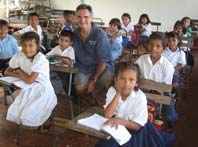
condition.
First, we visited a kinder garden in the small village of Los Trejos and
we were joined by Rochel Calero and Miguel Segueira. There, I
was able to meet the children, watched their activities and talk with their
teachers. Their daily lunch is provided by the women in the community. Before
WV builds this school, the young children were missing school. Their parents
could not send them to other schools as they were
too
far away. Now, thanks to WV, the children from this village can go to kinder
and also start their education in the first grade and then continue their schooling
in a bigger elementary school as they are old enough to walk to.
Our next stop was at a small farm in Las Conchitas community where the
family was taking part to a W V agricultural program. Like in El Salvador, this
program is made to teach farmers how to grow new crops in order to get a better
diet and to make a profit from the surplus.
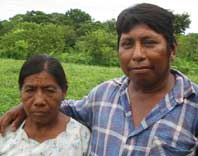
This
farmer (pictured with his wife) told me that 4 years ago he had been diagnosed
with a sickness similar to leukaemia. He was told that he would not survive
it. His five children took care of the farm as he was too weak to work. He had
to sell all his cattle in order to pay for the treatment but now, 4 years later,
he is well again and his farming is going very well. I wish him and his family
all the best for the future.
We also visited another farm where a new watering system had been installed.
Now, they are able to grow tomatoes
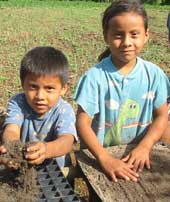
which
were impossible before. . The children go to school only in the morning and
help their father in the afternoon (pictured). This farmer was really taking
advantage of the program and was growing many things including, water melons,
cantaloupes, tomatoes, green beans, grenadines, pineapples and cucumbers. He
also told me that he was never able to borrow money before or if the bank did
give him a loan it was at a 25% annual interest but now, if he needs it, he
can borrow from WV at the rate of 0,5%. His farm is also used as a model for
other farmers. The whole family seemed very happy and prosperous. They told
me that for them the main change in their life was to be able to eat fresh fruits
and
vegetables. They are now in much better
health thanks to a better diet.
That concluded my visit of the Nindiri project and again, thank you to all the
people who took the time to help me. As usual, if you would like to help a family
in Nicaragua or somewhere else in the world just visit the World
Vision web site by clicking here..
Federico had organised an interview with a leading Nicaraguan newspaper at 6.30pm.
They were keen to publish my story and fortunately I had Federico to act as
my translator.
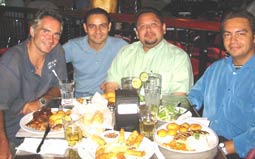
Being
the 12th of November it was my birthday and Federico invited me for dinner with
his friends Marvin and Rodolfo in a pleasant restaurant. Thank you guys, you
have made that evening very special for me and I will not forget it. I would
also like to say thank you to all of you who sent me an email for my birthday
and sorry if I have not reply yet.
I usually never ride at night for obvious reasons but I had to make an exception
and I made it safely back in Granada just before midnight.
The
next day, the three musketeers (pictured) got back on the road toward
the Island of Ometepe. Before I describe it let me tell you about a couple of
set back that occurred on the journey to the island. We rode to Rivas,
the place where we had to take the ferry, without any problem. We got there
at 10am, hoping to get onto the 10.30 ferry. We were mildly disappointed when
we were told that there was no room anymore for the bikes and that
we would have to wait until the next one. The
next one was due at 2.30pm. With plenty of time in our hands we decided to leave
the port and to go and wait in a nearby restaurant. Catherine Delannoy,
a charming Belgian lady who was also waiting for the next ferry, joined us (just
click hereto visit her web site). She was trying to get her car on a ferry
but she later found out that she would have to return to Managua and book a
ticket from there. She decided to leave her car in the port parking and to get
a ride with Albert (he was the only one with room on his bike). I warned her
about the danger of travelling with Albert. His latest conquest had just run
away from him or him from her, I never got to know exactly what had happen with
Femke. Never mind, Catherine was going to take the risk and she joined us in
the restaurant for a game of card and a meal, after all we had 4 hours to kill.
At around 1.30pm I pointed out that maybe we should make an appearance at the
dock. They all agreed but it took another 30mn to organise. In the meantime,
as it was time to pay the bill for our lunch, I got my money and put the rest
of it in my tank bag just a couple of meters from where we were sitting. I had
just the time to turn around and put the money on the table for someone to steal
the money from my bag. US$35, my budget for nearly 4 days, had disappeared in
not more than one minute of inattention. I don't have to tell you that I was
pretty pissed off, I mean, I spend my time trying to save a dollar here and
there and to lose such an amount was a catastrophe at that moment. I am confident
that I will eventually get over it but at that instant I could have killed the
entire population of Central America. Anyhow, when we finally got back to the
dock, we were told that we were too late again and that we would have to wait
for the next one, the 6.30pm one to be precise. By that time I was starting
to have doubt about my association with the other musketeers. Since I had been
with them everything seemed to go wrong, I had trouble with the police, had
money stolen from me, missed the ferry and lost at card games, what was next?
This time we decided not to leave the dock so we played card by the water. When
the ferry arrived it was dark and we had to ride our bike in the cargo hold,
a hole with a 60 degrees ramp. Inside the hole it was dark and full of engine
fumes. We managed not to damage our

bikes
and got comfortable for the one hour journey. Getting the bike out of the hole
(pictured) was another exciting experience which we survived. We found a cheap
place to stay and for US$2 per night we had a bed in a dorm.
The Isla de Ometepe is an ecological jewel and is set on the western
side of Lake Nicaragua. It is sparsely developed for tourism which makes it
more attractive for the three Musketeers as they like unspoiled nature and don't
mind expending extra effort to see it. Ometepe (meaning "between two hills")
is formed by two large volcanoes: Volcán Conception, which rises
1610m
above the lake in an almost perfect cone, and Volcán Madera, 1394m high.
Lava flowing from the two volcanoes created an isthmus between them to make
a single island. Conception is still active: its last major eruption was in
1957. With a population of 35,000, Ometepe is dotted by small coastal settlements
where people live by fishing and growing bananas, citrus fruits, maize, sesame,
beans and other crops in the fertile volcanic soil. While I am at it I will
add a couple of information about Lake Nicaragua. It is Latin America's third-largest
lake: It is 177km long by an average 58km wide. It is also said to contain the
world's only freshwater sharks.
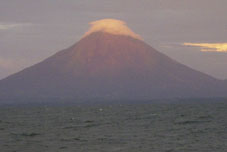
The
three Musketeers (actually 4 with Catherine who had just managed to keep her
virginity) had decided to climb Conception (Pictured) the next following
morning. Even though they had being advised to take a guide as the paths were
very hard to find and that rolling stones could break their legs, they still
wanted to do it on their own. They set out at 5am, riding their bikes to a small
town also called Conception. They were shown the path and the "Lover
Boy"
Musketeer, the one riding the Honda, decided to ride it as far as he could.
The other two, having no say on the matter, had to follow. The path was very
narrow, rocky and sandy. The "Bearded Monkey" Musketeer, the one riding
the KTM, was struggling along and I was not much better. Lover Boy had disappeared
with his virgin, not waiting for us. After few kms I stopped as the KTM rider
wanted to turn around and go back to Conception. We waited for a while hoping
that Lover Boy would turn around as well. I finally convinced the Bearded Monkey
to keep going for a while and we eventually caught up with the missing Musketeer
and his passenger. They had fallen down and were waiting for us. Luckily they
had not hurt themselves. We decided to leave the bikes right there in the middle
of the forest and started the climb. The path was narrow and steep and we could
hear the monkeys howling. After one hour, Catherine told us to keep going as
she was going to take a break and maybe return to the bikes. The Musketeers
kept going for another 2 hours but suddenly there were no more trees or vegetation
around and the wind was blowing hell. They were soaking wet with perspiration
and the wind made them cold. Then, they found themselves in a very thick fog
with no visibility whatsoever and that was when that they decided to call it
a day and to turn around. They guessed that they were only about 400m from the
summit but to continue in those conditions was asking for trouble. When they
finally got back to the bikes, having met up with Catherine along the descent,
the Bearded Monkey noticed that someone had stolen his rain gear while they
were climbing. Once again, they were reminded that Nicaragua is not as safe
as one could think.
The next day we rode to the village of Altagracia, on the other side of the
island. We were going there to see the San Diego fiesta, an annual festival.
We stopped along the dirt road a few times in some small villages. It was nice
to observe the children playing or watching the farmers riding their
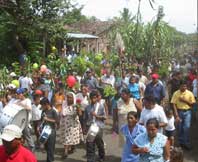
bulls
as one would ride his horse. In Altagracia, we first saw the procession
(photo) then we went straight to the rodeo. It was nothing like what I had seen
in Guatemala. They were very disorganised and the poor bulls looked and acted
so tired that it was painful to watch them. Another thing that surprised us
was the number of travesties. Apparently they come from other parts of Nicaragua.
No one seemed to pay much attention to them as they are used to see them every
year at the festival. They were all selling things and mixing with the locals.
I was not able to get more information about their presence there.
Two
days later we left the island but this time we made sure not to miss the first
ferry. My last stop was in San Juan Del Sur. Set on a stunning horseshoe-shaped
cove with dramatic cliffs forming the far edges, San Juan is a fishing village
which is very quiet and relaxing. A perfect place to recover for the tired Musketeers.
JOURNAL 28.
20/11/03 . Nicaragua . Kilométrages
jusqu'à maintenant 53,415km
Les aventures des trois
mousquetaires.
It
is also in this region that sea turtles come to lay their eggs on the beaches
from July to August. Because the three Musketeers are also enthusiastic ecologists,
they could not miss this very rare phenomenon. They all went there one evening
but this time they decided to go in Catherine's car. The beach was around 24
km away from San Juan but the road was in extreme bad condition and Catherine
had to work very hard to get them there. She
had
to cross three rivers and likely her Nissan 4 wheels drive was up to the job.
They got there at 7pm just to be told by the rangers that they would have to
wait until 10pm. They waited patiently while changing a flat tyre. The turtles,
weighing between 35 to 45 kg, come three times a year to lay their
eggs.
It digs a deep hole in the sand and lays between 80 to one hundred eggs in it.
One egg is around the size of a golf ball. Once it has laid all the eggs it
covers them with sand and returns straight to the sea. Forty five days later,
the little babies turtles are born but only 80% of the total will be alive.
The babies will then go straight to the sea and they will come back exactly
where they were born 7 years later to lay eggs. Not many babies survive the
sea, they obviously get eaten. It was a pleasure for the three Musketeers to
witness this miracle of life and that night, they dreamed of turtle soup and
delicious omelettes.
I
am now heading to Costa Rica and to Panama.
Will the three Musketeers stay together for more thrilling adventures?
Will they decide to go their own way?
Make sure to find out in my next update.
Adios from the tres desperados.
Click here to view more photo.
Lundi
3 Novembre 2003.
Quelques jour auparavant j'avais découvert qu'il y avait un concessionnaire
BMW à San Salvador mais comme c'était le week end j'avais du attendre
le Lundi matin pour qu'ils viennent la chercher. Ils sont donc venus à
huit heures du matin la chercher avec une remorque. Je suis allé avec
eux et le chef mécanicien, Rafael Segura, n'a pas perdu une seconde
et s'est aussitôt occupé de ma moto. Après l'avoir brancher
sur un ordinateur il s'est tout de suite aperçu que le problème
venait de la batterie et pas de l'alternateur comme j'avais pensé. Il
n'avait pas de batterie en stock donc il en a récupéré
une
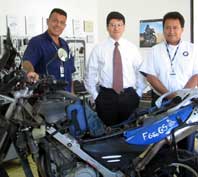
sur
une des motos neuves pour remplacer la mienne. Ensuite j'ai rencontré
le propriétaire, Hernán Orellana, qui m'a demandé
si j'étais intéressé de venir le lendemain pour une conférence
de presse, en échange il me donnait la batterie pour rien. Bien entendu
j'acceptais et il venait me chercher personnellement le lendemain après
midi. Plusieurs journalistes nous attendaient ainsi que la télévision.
Il y avait une table d'honneur où je m'installais entre le propriétaire
et le représentant de chez BMW. Après avoir fait une rapide présentation
de mon voyage à l'aide de mon ordinateur et d'un projecteur, je répondais
aux questions des journalistes. La
conférence
de presse était conclue par un cocktail fourni par BMW, malheureusement
tout le monde voulait me parler ce qui m'empêchait de me remplir la panse
de toutes ces délicieuses choses. J'aimerai remerciais au passage
Europa Motors, en particulier Hermán Orellana, Ricardo Avilés
et Rafael Segura pour leurs assistances.
Je reprenais la route de bonne heure le lendemain avec l'espoir de franchir
la frontière d'Honduras. J'ai vraiment bien aimé le Salvador;
les gens étaient toujours très amicales et accueillant. Beaucoup
m'ont racontés leurs expériences pendant la guerre et ils étaient
toujours prêts à me donner leurs opinions sur la politique actuelle
de leur pays. Les enfants étaient toujours très polis, curieux
et rapide à sourire.
Je suis arrivais à la frontière d'Honduras vers 11 heures du matin
et j'y passais 3 heures. Encore une fois je devais me battre avec toute la bureaucratie
et payer plus de 40 Euros juste pour la moto. Comme j'avais déjà
visité ce pays auparavant et que j'étais un peu en retard sur
mon programme je décidais de traverser rapidement l'Honduras et d'aller
directement au Nicaragua. Il m'aurait été possible d'être
à la frontière du Nicaragua ce soir là mais je ne pouvais
absolument pas me farcir deux frontières en un jour. J'en ai tellement
horreur que mon endurance mentale n'aurait pas pu résister. Je me suis
arrêté dans la petite ville de Choluteca pour la nuit et après
un bon repas je me préparais mentalement pour le lendemain matin.
Je suis arrivé à la frontière du Nicaragua à 8 heures
le lendemain matin et je passais deux bonnes heures à remplier des papiers,
à faire des dizaines de photos copies et à aller d'un bureau à
l'autre par une chaleur accablante. Je payais 30 Euros pour les permis nécessaire
et je me faisais aussi voler de plusieurs Euros en changeant de l'argent.

Le
Nicaragua est le plus grand pays d'Amérique Centrale. Il est entouré
par l'Honduras au nord, par la Costa Rica au sud, la mer Caraïbe à
l'est et le Pacifique Océan à l'ouest.
Les évènements politiques des dernières générations
ont eu un grand impact sur la perception de ce pays sur les étrangers
et beaucoup de touristes évitent ce pays. J'y suis venu il y a de ça
une dizaine d'années et je me rappelle avoir été agréablement
surpris par tous les volcans, les rivières navigables, les villes coloniales
et aussi par les plages désertes.
Economiquement, le Nicaragua reste un des plus pauvres pays de la région,
avec au moins 50% de sa population vivant au dessous de la ligne de pauvreté.
Naturellement
l'ouragan
Mitch, qui a tout détruis sur son passage, n'a rien fait pour arranger
les choses en automne 1998.
Il y a environ 5,2 millions d'habitants et ce sont les métis qui forment
la majorité de la population.
Les premiers 60 Km après la frontière étaient sur une route
non goudronnée. La route par elle-même n'était pas particulièrement
mauvaise mais c'était la poussière des camions et des bus, passant
à haute allure, qui posait un problème. Ensuite la route c'est
beaucoup améliorée et je passais Managua (la capitale) en début
d'après midi sans m'y arrêter et je continuais directement jusqu'à
Granada, mon objectif de la journée.

Granada
est la plus vieille ville Espagnole du Nicaragua et comme Antigua au Guatemala,
a conservé son héritage d'architecture coloniale. Pour ceux qui
sont intéressés, elle a été fondée en 1524
et se situe au pied du volcan Mombacho au nord-ouest du lac Nicaragua. Elle
a une population de 85 milles habitants et j'ai aussi lu quelques part que les
habitants de Granada ont la réputation d'être un peu des snobes.
Par
exemple, ils conduisent leurs voitures par
des températures oppressives avec leurs fenêtres fermées
de façon que les gens pensent qu'ils ont les moyens d'avoir la climatisation.
Néanmoins, c'est une petite ville calme et merveilleuse et je décidais
d'en faire mon point de chute pour une semaine.
Le lendemain je retournais à Managua pour rendre visite au bureau
national de World Vision. J'y rencontrais Maria José Jimenez et elle
me donnait rendez-vous pour le mercredi suivant pour visiter un projet dans
le village de Nindiri. Pas très facile pour trouver son chemin dans
Managua car les rues n'ont pas de noms. Les grands édifices, les ronds-points
et les feux tricolores servent de points de référence et les
adresses sont décrites par rapport à ces points. Par exemple,
World Vision se trouve au nord du quartier nuevo et à 200m après
les feux. Pour rendre les choses plus compliqués, des fois ils se servent
de point qui n'existe plus. Le plus facile c'est de demander son chemin sans
arrêt et heureusement mon Espagnol s'améliore de plus en plus.
Managua a souffert de nombreux désastres naturels et la ville a été
complètement détruite plusieurs de fois. Le centre colonial
fut détruit par un tremblement de terre en Mars 1931, et fut ensuite
ravagé par un incendie 5 ans plus tard. Elle fut complètement
reconstruite mais détruite une fois encore par un tremblement de terre
en Décembre 1972. Cette fois ci la ville fut rasée, tuant 6000
personnes et laissant plus de 300,000 habitants sans abris.
Samedi 8 Novembre.
Albert Hörmann, mon ami Autrichien pilotant une 750cc Honda, était
lui aussi à Granada et nous organisions d'aller visiter le volcan Masaya.
Steffen Utzmann, un Allemand pilotant une 640cc KTM d'Alaska jusqu'en
Argentine, décidait de nous accompagner (les trois mousquetaires).
Nous sommes partis vers 8 heures du matin pour le parc national de Masaya
qui se trouve à environ 30 Km au nord de Granada. Le volcan de Masaya
et celui de Nindiri comptent 5 cratères dont celui de Santiago qui
est toujours actif. La légende dit que les indigènes de la région
jetaient les femmes dans la lave bouillante du cratère pour apaiser
Chaciutique, la déesse du feu, et des squelettes de sacrifice humains
ont été retrouvés dans des tunnels avoisinants. Ils nous
étaient possible d'aller en moto jusque sur les bords du cratère
et le là nous avions des vues superbes de toute la région. Après
une petite promenade nous reprenions les motos avec l'intention d'aller visiter
le petit village voisin de Catarina. La route était belle mais la circulation
était chargée. Dans un virage, deux d'entre nous entreprirent
de doubler une voiture alors qu'il y avait une ligne continue. Je dois avouer
qu'il n'y avait rien d'inhabituelle à ça car tout le monde le
fait mais malheureusement pour nous les gendarmes étaient présents.
J'ai bien entendu les coups de sifflets mais comme mes camarades ne s'arrêtaient
pas je continuais aussi. Quelques kilomètres plus tard j'apercevais
dans mon rétro un taxi qui nous poursuivait à toute allure et
je pouvais voir un gendarme gesticulant comme un malade par la fenêtre
du passager. Ils nous dépassaient et nous forçaient à
nous arrêter. Le gendarme se précipita rapidement vers nous et
je voyais bien que ce n'était pas pour nous donner un certificat de
bonne conduite. Il nous ordonnait de lui donner nos permis de conduire et
nous verbalisait de 400 Cordobas chacun (28 Euros). Il nous disait aussi que
nos permis nous seraient rendus que lorsque nous aurions payé l'amende.
Les choses se compliquèrent quand il nous dit que nous ne pouvions
payer l'amende que dans une banque et comme c'était Samedi les banques
étaient fermées. Ils nous fallaient revenir le Lundi suivant
pour la payer et récupérer nos permis.

Il
nous donnait un petit carton jaune qui allait nous servir de permis jusqu'à
Lundi (photo).
La bonne humeur avait fait place au désespoir et nous continuons quand
même jusqu'à Catarina. Ce petit village est réputé
pour son point de vue qui offre des vues incroyable sur le lac Apoyo, lac Nicaragua
et sur la ville de Granada. Les visages grincheux disparaissaient rapidement
et on passait l'après midi à visiter la région en rigolant
de la façon que le flic nous avait poursuivit.
Mercredi
12 Novembre.
Je quittais Granada tôt le matin et j'allais directement à Managua
pour mon rendez-vous avec World Vision. Le programme que nous devions
visiter n'était qu'à une heure de Managua et Maria José
m'y conduisait en compagnie de Fédérico Rostran, relation
publique, et aussi mon traducteur pour la journée.
Ce projet est financé par l'Australie et il a débutait en 1988.
Il compte actuellement plus de 3400 enfants parrainés qui sont répartis
dans 9 communautés. Les habitants de cette région sont principalement
des fermiers et vivent de la culture de maïs, d'haricot secs et d'élevage
de bétail. Il y a surtout un manque de centres médicaux et d'écoles.

Nous
sommes d'abord allés visiter une école maternelle dans un petit
village voisin qui s'appelle Los Tréjos. Là, j'ai pu rencontrer
les enfants, connaître leurs activités et parler avec leurs instituteurs.
Ceux sont les mamans qui viennent leur préparer Le repas du midi. Auparavant,
les petits de cette communauté ne pouvaient pas aller à l'école
car la plus proche était à plusieurs kilomètres mais maintenant,
depuis que WV a construit cette école, ils peuvent y aller dés
l'age de 3 ans jusqu'à 7 ans. Ensuite ils sont assez grands pour aller
dans les
écoles
élémentaires de la région.
Après la maternelle nous sommes allés visités une famille
de cultivateur dans la communauté voisine, Las
Conchitas.
Cette famille fait parti d un programme d'agriculture soumis par WV. Comme en
Salvador, ce programme est fait pour enseigner aux cultivateurs d'autres méthodes
d'agriculture qui vont leur permettre de cultiver d'autres produits. Ce qui
leur permettra d'avoir une meilleure nutrition et aussi d'avoir une rentrée
d'argent supplémentaire avec la vente du surplus de la récolte.
Le fermier me raconta que 4 ans plus tôt il avait été informé
qu'il souffrait d'une maladie un peu similaire de la leucémie et que
ses jours étaient comptés. Ses 5 enfants prirent la ferme
en main car il n'en était plus capable. Il avait aussi du vendre tout
son
bétail pour payer les médicaments.
Maintenant, 4 ans plus tard, il n'est plus malade et sa ferme est très
prospère. Je lui souhaite, ainsi qu'à toute sa famille, une bonne
santé et tout mes vœux de bonheur pour le futur.
Nous avons aussi visité une autre ferme où un nouveau système
d'arrosage avait été installé. Maintenant, ils

peuvent
faire pousser des tomates alors que c'était impossible avant. Les enfants
vont à l'école seulement le matin ce qui leurs permet d'aider
leur père l'après midi(photo). Ce fermier avait vraiment pris
avantage du programme et je pouvais trouver toutes sortes de fruits et légumes
comme par exemple des pastèques, melons, tomates, haricots secs, grenades,
ananas et concombres. Il me disait aussi qu'il avait la possibilité d'emprunter
de l'argent directement à WV si nécessaire à seulement
0,5%. Dans les banques le taux d'emprunt est de 23%, donc impossible pour lui
de rembourser de telles sommes. Sa ferme sert aussi de modèle aux fermiers
de la région. Ils me disaient que pour eux, ce qui a le plus changé
leurs vies, c'est de pouvoir manger des fruits et des légumes frais,
ce qui leur permet d'être tous en très bonne santé.
J'aimerai
remercier tout ceux qui ont pris le temps de m'accompagner et comme d'habitude,
si vous aimeriez assister une famille ou un enfant ici au Nicaragua ou autre
part dans le monde, n'hésitez pas à contacter World Vision France
en cliquant ici.
Fédérico
avait organisé une entrevue avec un des plus connus journal du Nicaragua
à 18.30 heures. Le journaliste était intéressé de
publier mon histoire et heureusement j'avais Fédérico pour traduire.
Comme c'était le 12 Novembre, jour de
mon anniversaire, l'équipe de WV m'invitait au restaurant pour arroser
ça. J'en profite au passage pour remercier tout ceux qui m'ont envoyé
des émails pour cette occasion ce jour là et si je ne vous ai
pas encore répondu je vais le faire d'ici peu.
port et d'aller attendre dans un restaurant voisin.
Catherine De Lannoy, une charmante señorita de Belgique qui aussi devait
attendre le prochain ferry, se joignait à nous (vous pouvez en savoir
plus sur cette énigmatique jeune femme en consultant
son site Web).Elle essayait de mettre sa voiture sur le ferry mais apprenait
plus tard que la seule façon de le faire était de retourner à
Granada et de faire une réservation. Elle décidait de laisser
sa voiture dans le parking du port et de nous accompagner. Nous passions les
quatre heures d'attente en jouant aux cartes et à manger une croûte.
Vers 13h30 j'indiquais qu'il serait temps d'aller sur le port. Il était
d'accord mais nous perdions une demie heure encore à nous préparer.
Toujours est-il que lorsque l'on s'est pointé au ferry celui-ci était
encore une fois plein. Il nous fallait attendre le prochain et dernier de la
journée prévue à18h30. Cette fois nous décidions
de ne pas quitter le port. Mais revenons au restaurant un instant, juste le
temps de vous expliquer comment une minute d'inattention peut changer beaucoup
de chose. Nous avions garé les motos juste à quelques mètres
de nous, ce qui nous permettait de pouvoir toujours garder un œil dessus.
Quand ce fut l'heure de payer l'addition, je payais ma part comme tout le monde
et mettais le reste de mon argent (environ 35 Euros) dans ma sacoche de réservoir
que j'avais laissé sur la moto. Le temps de me retourner pour demander
si tout le monde était prêt à partir que quelqu'un s'emparer
de mon argent sans que personne le remarque. Mon budget de 4 jours disparaissait
en une minute. Pas besoin de vous dire que je m'en voulais, je passe mon temps
à essayer d'économiser un Euro par ci par là. Bien sur
je vais m'en remettre éventuellement mais en attendant j'aurai pu éliminer
la population entière d'Amérique Centrale de mes propres mains.
Je commençait sérieusement à me poser des questions sur
mon association avec les deux autres mousquetaires car depuis que j'étais
avec eux j'avais eu des problèmes avec la police, rater deux fois le
ferry, fais voler de l'argent, perdais au jeu de carte et pour combler tout
la France perdait contre les Anglais au championnat du monde de rugby en Australie.
Il faisait nuit quand le ferry est revenu et pour rendre les choses plus compliquées
nous devions descendre les motos dans la cale. C'est sur une rampe inclinée
à 60% que nous sommes descendu dans un trou noir plein de fumée
des moteurs. Après avoir bien soigneusement attacher les motos nous nous
installions confortablement pour la traversée. Le débarquement
fut encore une fois une excitante proposition mais qui se passa sans casse.
L'île de Ométépé est un bijou écologique.
Elle se trouve à l'ouest du lac Nicaragua et n'est pas vraiment développée
pour le touriste ce qui la rend très accueillante pour les trois mousquetaires
car ces derniers sont venus pour découvrir la nature et ils ne vont pas
hésités à faire quelques efforts en plus pour la voir.
Elle est formée de deux volcans, celui de Conception (1610m) et celui
de Madera (1394). Avec une population de 35,000 habitants, Omépété
est parsemé de petits villages le long de la côte où les
habitants vivent de la pêche et de la culture de bananes et maïs.
Pendant que j'y suis, je vais vous donner quelques infos sur le lac Nicaragua.
C'est le troisième plus grand lac d'Amérique Latine: il fait 177
Km de long et une moyenne de 58 Km de large. Il est le seul au monde où
l'on peut trouver de requins d'eau douce.
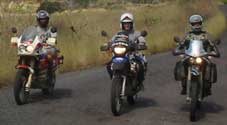
Le
lendemain, les trois mousquetaires (photo) prenaient la route pour l'île
de Ométépé. Avant de vous parler de cette île
j'aimerai vous faire partager quelques anecdotes qui nous sont arrivées
ce jour là. Pas de problèmes jusqu'à Rivas où nous
devions prendre le ferry. Nous y étions à 10 heures en espérant
pouvoir prendre celui de 10h30. Nous étions un peu déçu
d'apprendre que celui-ci était déjà plein et que nous devions
attendre le prochain qui devait partir à 14h30. Avec pas mal de temps
de libre nous décidions de sortir du

Les
trois mousquetaires (4 avec Catherine) avaient décidaient d'escalader
le volcan Conception (1610m), le plus haut des deux et le seul encore
actif. Bien qu'on leur avait conseillé de prendre un guide ces derniers
décidaient de tenter leurs chances et de le faire eux-mêmes. Ils
partaient à 5 heures du matin en moto jusqu'au petit village de conception.
Là, des gens leur indiquaient le chemin à prendre et l'Autrichien,
fier d'avoir une belle demoiselle sur sa monture, insistait à continuer
en moto le plus loin possible. Les deux autres, n'ayant rien à
dire sur sa décision, le suivirent.
Le chemin était très étroit, sableux et caillouteux.
L'Allemand, sur sa KTM, avait du mal à suivre et l'Australien n'était
guère plus à l'aise. Après plusieurs kilomètres
l'Autrichien et sa compagne avaient disparu dans les bois, sans attendre les
deux autres. Ces derniers s'arrêtèrent pour se consulter, l'Allemand
voulait faire demi tour mais l'Australien réussi à le convaincre
de continuer encore un peu. Ils s'enfoncèrent dans la forêt et
soudainement, à l'orée d'une clairière, retrouvèrent
les deux échappés. L'Autrichien avait chuté, sans blesser
personne mais encore tout penaud et honteux. Ils décidèrent
de laisser leurs motos sur place et commencèrent l'ascension. Le chemin
était devenu un sentier étroit qui montait droit vers le sommet.
La pénible montée avait mis fin à tout discourt et l'escalade
se faisait dans le grand silence que seul les grognements des singes venaient
troubler. Après une heure, Catherine leur demanda de ne pas l'attendre,
elle allait continuer doucement et éventuellement retournait aux motos.
Les trois mousquetaires continuèrent pendant deux heures toujours sans
un mot et ne s'arrêtant que de temps en temps pour boire une gorgée
d'eau. Ils étaient couverts de sueur et leurs vêtements étaient
trempés. Brusquement la forêt disparu et ils se retrouvèrent
en plein milieu du brouillard sans aucune visibilité. Ils avaient froid
car un vent soufflant très fort les attendait et leurs habits trempés
n'arrangeaient rien. Ils estimèrent qu'ils étaient à
pas moins de 400m du sommet. Bien que téméraires et vaillants,
les mousquetaires n'étaient pas non plus des idiots et ils préférèrent
faire demi tour plutôt que de risquer leurs vies. Quand ils sont finalement
revenus aux motos, ayant retrouvé Catherine au passage, l'Allemand
remarqua que quelqu'un lui avait volé sa combinaison de pluie qu'il
avait laissé bêtement sur sa moto. Encore une fois, ils remarquèrent
que le Nicaragua n'est pas aussi sur et tranquille qu'on pourrait le penser.
Quelques jours suivant nous allions à
Altagracia, un village de l'autre coté de l'île car c'était
la fête patronal. Nous nous arrêtions plusieurs fois le long de
la route, qui n'était guère plus qu'un chemin, pour visiter
d'autres petits villages. C'était agréable de pouvoir observer
les enfants qui jouaient dans les cours ou les fermiers qui

se
déplaçaient sur le dos des bœufs. In Altagracia, nous avons
d'abord vu la procession religieuse (photo) puis nous sommes allés directement
voir le rodéo. Cela n'avait rien à voir avec le rodéo que
j'avais vu au Guatemala. Ils étaient très désorganisés
et les pauvres taureaux avaient l'air si fatigué que cela faisait mal
à voir. Quand le taureau, mort de fatigue, se couchait au milieu de l'arène,
un des matadors lui mordait la queue si fort que la pauvre bête bondissait
en l'air. C'était vraiment cruel à voir et nous ne sommes pas
restés longtemps. Une autre chose qui nous a beaucoup surpris, c'était
le nombre de travestis qui paradaient le long des rues. En fait, ils ne viennent
pas
du village mais ils viennent de différents coins du Nicaragua. Personne
ne prête guère attention à leurs présences et tout
ce passe bien.
Deux jours plus tard nous quittions l'île mais cette fois nous réussissions
à prendre le premier ferry sans problème. Ma dernière halte
au Nicaragua avant le Costa Rica était dans un petit village de
bord de mer au long du Pacifique. San Juan Del Sur est un paisible village
de pêcheurs sur les bords d'une baie magnifique en forme de fer à
cheval. Un endroit idéal où les trois mousquetaires pouvaient
se remettre de leurs aventures.

C'est
aussi dans cette région que les tortues viennent pondre leurs œufs
sur les plages du mois de Juillet jusqu'en Janvier. Comme les trois mousquetaires
sont des écologistes à 100% il leur était primordial d'aller
voir ce rare phénomène. Ils décidèrent d'y aller
tous un soir dans la voiture de Catherine. La plage se trouvait à environ
24 Km de San Juan mais la route était vraiment en mauvaise condition
et Catherine nous fit une démonstration de 4x4 dans sa Nissan. Ils arrivèrent
vers 19 heures mais les gardes leur
disaient
que les tortues ne sortiraient de la mer que vers 22 heures. Ils attendirent
patiemment. Les tortues, pesant entre 30 et 45 kg, viennent pondre sur cette
plage trois fois par an. Ils creusent un grand trou dans le
sable et y déposent entre 80 et 100 œufs.
Les œufs sont à peu prés de la taille d'une balle de golf.
Une fois qu'elle a pondu elle les recouvre de sable et retourne dans la mer.
Quarante cinq jours plus tard, les petites tortues naissent mais seulement 80%
vont éclore. Ils vont directement dans la mer et bien entendu seulement
un très petit pourcentage va survivre dans la mer. Ils reviendront 7
ans plus tard, exactement à la même place où ils sont nés,
pour pondre à leur tour. Les trois mousquetaires eurent le plaisir de
découvrir ce phénomène à la lueur de leur lampe
de poche et ce soir là, ils rêvèrent de soupe à la
tortue et d'une bonne omelette. Kilometrages
Demain je reprends la route vers le Costa Rica.
Est
ce que les trois mousquetaires vont rester ensemble pour d'autres excitantes
aventures?
Ou vont-ils décider d'aller chacun de son coté?
Ne manquez surtout pas la suite de cette aventure captivante pendant que je
me prépare moralement pour la Colombie.
Adios de los tres desperados.
The three Musketeers.
Les trois Mousquetaires.
Steffen, Albert, yours truly
and Femke.
Local man carrying baskets.
Marchand de panniers.
Children at kinder garden.
Les enfants à l'école maternelle.
Local farmer riding his bull.
Fermier sur sa monture.
The Musketeers with Catherine.
Les Mousquetaires en compagnie de Catherine.
Children who need your help.
Des enfants qui ont besoin de vous.
 |
 |
 |
 |
 |
 |
 |
 |
 |
 |
 |
 |
 |
|
JOURNAL 28.
20/11/03 . Nicaragua . Total
mileage so far 53,415km .
(Pour la version française
du journal, allez au bas de la page ou cliquez
içi.
Pour revenir à la version française du site, cliquez
sur Français)
How
can you help make Ride4Kids a worthwhile project? To find out,
click here.
|
|
